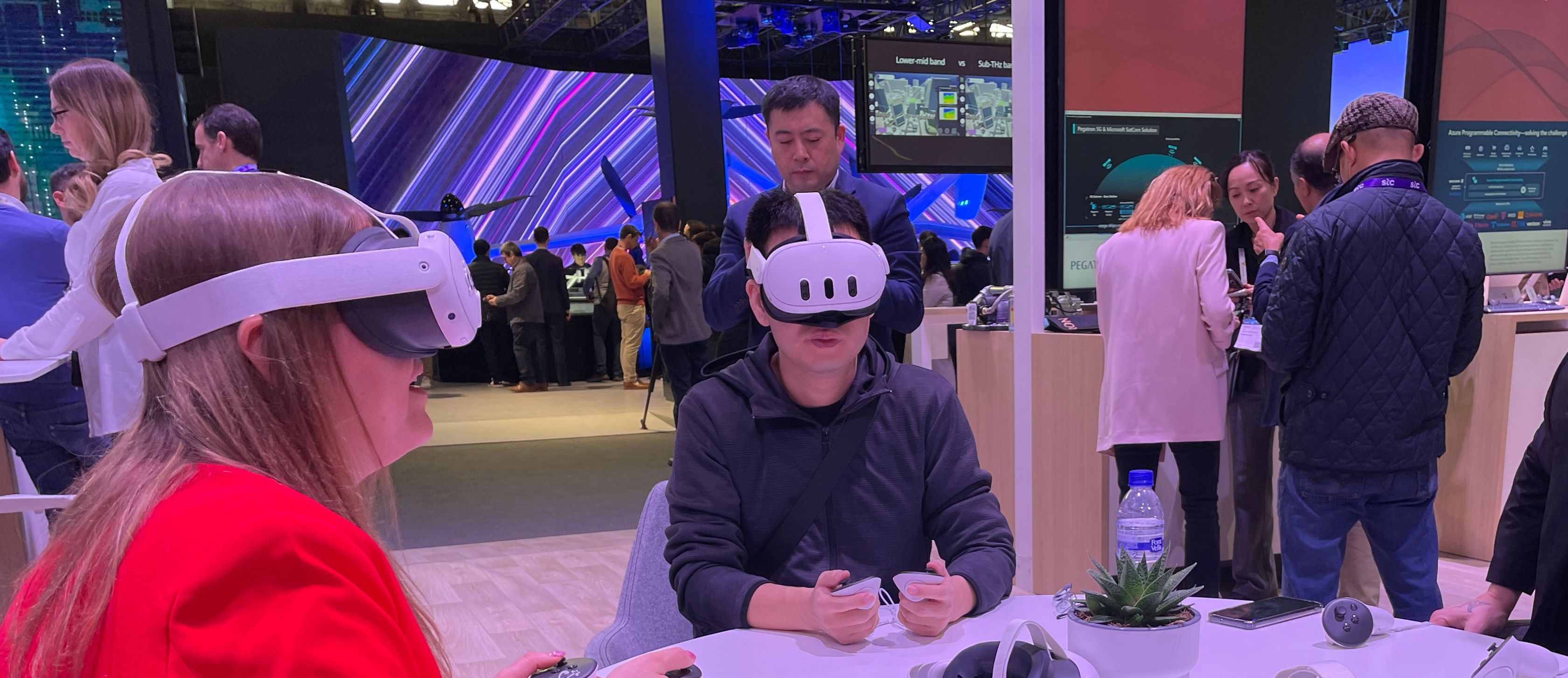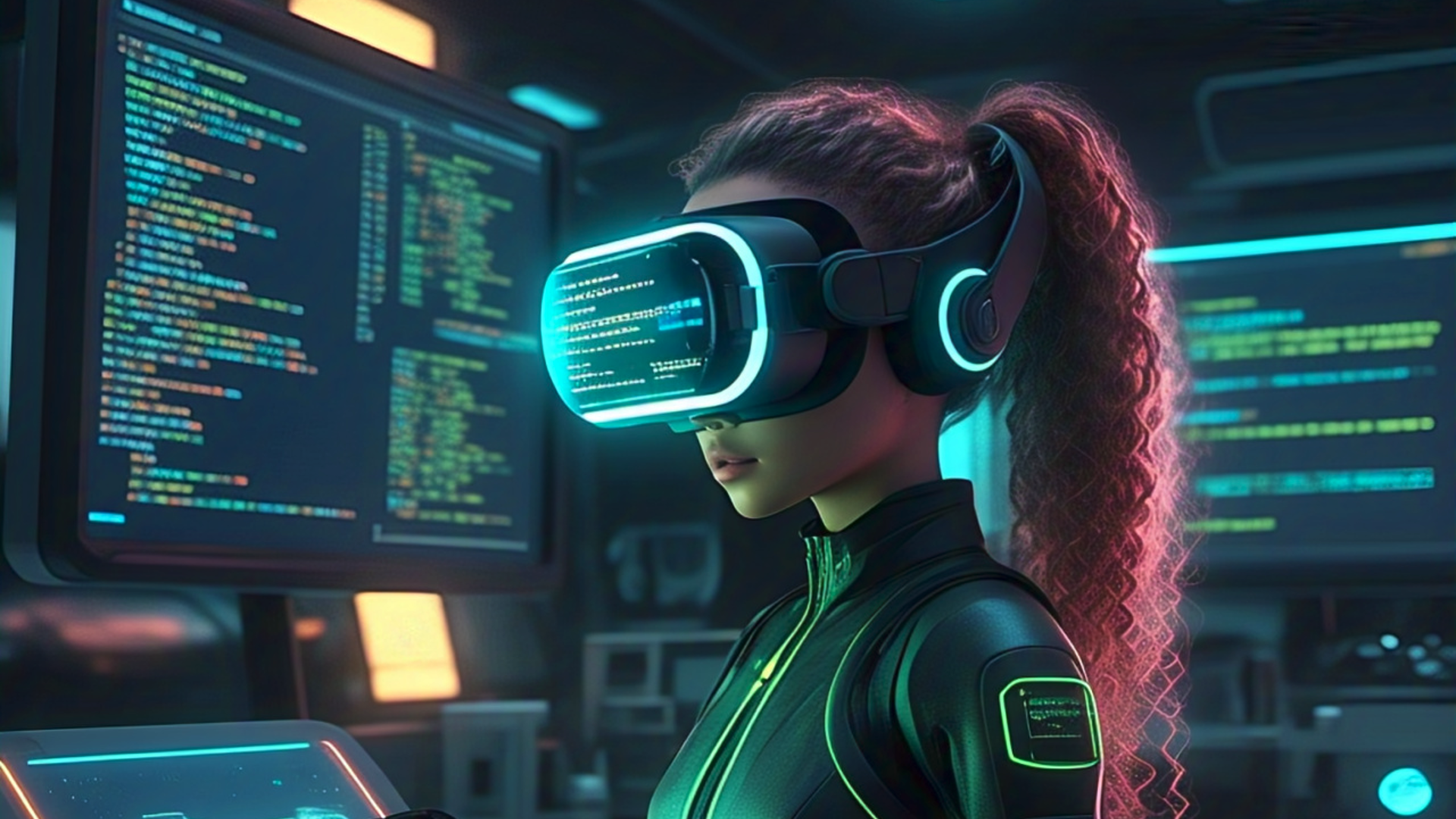Although new mobile phone announcements at the GSMA’s annual Mobile World Congress in Barcelona are fewer than in past years, “hardware” remains an important theme for the show’s nearly 2500 exhibitors. I went to MWC 2024 to check out the latest hardware suitable for Enterprise AR. I found it in many forms: dozens of wearable devices and chips as well as networking components with which operators will be able to build AR-enabled solutions for customers.
First, a short step backward: as recently as 2022, I still needed to define a few basic “AR” concepts for some exhibitors, (particularly those proposing VR solutions). No longer necessary in 2024. Some marketing professionals tried to attract the maximum number of MWC attendees to their stands by promoting XR solutions, but the engineers staffing those demos didn’t mince words: AR features the physical world; VR doesn’t.
Hardware in Action
Now about that hardware: it ranged from fully integrated wearable AR displays to highly specialized chips to address some of our industry’s nagging challenges. Wearable devices were exhibited in almost all the halls, in no less than 30 booths. A few app development service providers attracted crowds by using their Apple Vision Pro’s tethered to a display to demonstrate their new moves. They were not offering visitors an opportunity to try on the VisionPro.
A few people (wearing exhibition visitor badges) were walking around visiting booths with their Magic Leap 2 units tethered to their phones. I only ran across three demos featuring HoloLens2 (one of those was Taqtile showing Manifest over Private 5G in the Microsoft stand) and the same number using RealWear Navigators. In the spot that Vuzix usually occupies in Congress Square, Nulitics and Wideum, a pair of resellers, were showing their integrations for enterprise and industrial use cases with Vuzix Shield.
Qualcomm’s two public XR stations balanced device and networking tech. Since it doesn’t present information to the user in real-time, the RayBan Meta Smart Glasses (designed by EssilorLuxottica) is not, strictly speaking, an XR device but it was being demoed with a network concept device developed in partnership with Vodafone and built using the SnapDragon Platform and leveraging the Qualcomm Spaces: the HyperReality+ Hub.
Also on the network side, HoloLight was showing XR experience streaming for enterprises and interoperability using the HoloLight Hub platform. While visitors to the Qualcomm booth waited for their turns for a demo, they could examine the wide range of SnapDragon XR2 reference designs and partner products in a large glass case. Spoiler alert: no surprises in the case.
So, with the usual suspects spotted, where were the other devices that caught my attention? An exhaustive list isn’t in scope for this post so here are highlights: In the Taiwan pavilion, Jorjin was showing designs spanning the very earliest AR glasses (remember the Moverio line?) to their latest models: the J7M and J8L.
In the Israel pavilion, Everysight was back (we saw them at MWC 2019 and they were also at CES 2024) showing its latest model: the Maverick, weighing only 47 grams and an 8-hour battery life (full disclosure: these glasses are designed for use while doing sports, enterprise use cases are not in scope for the company at this time).
The line-up of different form factors on display at the Model Solutions booth was broad. Staff in the Model Solutions booth shared that many of the systems on display are not new (in fact, they were shown when the subsidiary launched at CES 2021) and are now in use internally by employees of the parent company, Hankook, one of Korea’s technology companies.
Pegatron, a spin-off of Taiwanese giant ASUS manufacturing laptops and communications equipment that has since become a leading component provider for Tesla, is another company that developed its own AR devices for internal use and exploring how to leverage their know-how externally. While Pegatron’s glasses lack a developer ecosystem to create new apps, not everyone needs hundreds of apps to be commercially successful. 
AI Everywhere
Artificial Intelligence can fill many gaps and, being the current tech industry buzzword, was visible on nearly every stand, frequently paired with AR. One example was Oppo. It debuted the Air Glass 3 concept, a wearable display using the company’s waveguides connected to a Large Language Model (LLM) and AI in its booth.
The AI-assisted wearable displays are not limited to AR use cases. One newcomer to the XR lineup is a Chinese mobile phone manufacturer well-established in emerging markets, Tecno Mobile. The company introduced its first glasses solution: AR Pocket Vision, a 3D video viewing platform using an AI vision algorithm to track user head orientation when paired with its Windows-based game controller, Pocket Go. 
Components are also important
The XR hardware shown at Mobile World Congress wasn’t limited to fully integrated displays. There were new waveguides shown by Immersia and XPANCEO showcased four smart contact lens prototypes. In the Belgian pavilion, VoxelSensors demonstrated its technology (introduced at CES 2024): the Single Photon Active Event Sensing (SPAES) tech which, using a single illuminator, enhances the mobile device user experience. It could easily be used to provide device security and efficiency of face authentication systems, one of the gaps enterprises currently face when providing a limited number of AR devices to many users (not the normal definition of “multi-user”).
In the Finnish pavilion, we discovered SeeTrue, a medical-tech hardware company that has some advanced eye-scanning technology that it provides for AR-assisted microscopes. Down the road, the same tech could be adapted to address secure AR display user authentication.
And the discoveries continued beyond displays and vision. As seasoned AR professionals realize, there are more senses to be addressed than there are solutions currently targeting them: at least a dozen MWC exhibitors including Gaudio Lab, Humane and, uSound were showing spatial audio hardware and software, most suitable for future AR devices. Haptic sensors and tactile devices are also part of the equation for some industrial AR use cases.
More to Come in 2024
For those who are frustrated by the lack of diversity and innovation in AR display hardware and components with which to build new, more powerful, but less power-hungry displays, it’s not too late!
A few days spent at Mobile World Congress made it clear to me that there are many more new (and not-so-new) providers of integrated AR solutions from which companies can choose. There are also so many new enabling technologies on chips on their way to commercialization to be included in future AR solutions.
“Just hardware” isn’t going to help anyone so, rest assured, there were legions of software developers also exhibiting at MWC but not mentioned in this post. They demonstrated that they are eagerly coding, most of them integrating the latest AI components for delivering rich experiences with lower cognitive loads on future users.
Since Mobile World Congress is an indicator of what’s to come in the year ahead, I’m confident that there will be many exciting announcements at AWE in June!
Join the 15th AWE USA and save up to $800 when you register by Mar 21, 2024.
–
About the guest author:
Christine Perey is an industry analyst and active leader of new technology industry initiatives. Her company provides insights, services and programs for executives building and acquiring AR-enabling technologies as well as to the largest enterprise Augmented Reality (AR) platform customers.
She is the founder, and from 2013 to 2016 served as the founding executive director, of the AR for Enterprise Alliance (AREA), the only global member-based organization accelerating AR adoption in enterprise. She is a world-renown advocate for open and interoperable AR and serves on numerous boards and standards working groups.



